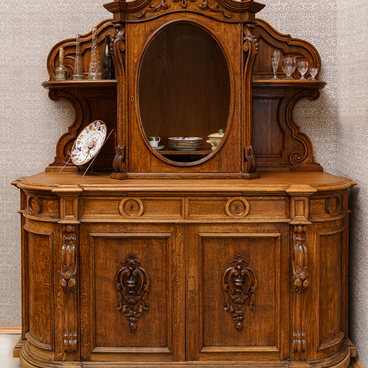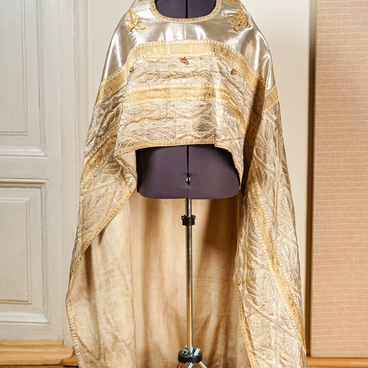Ivan Ivanovich Durdin, a representative of the third generation of St. Petersburg brewers, established his own beer factory in Rybinsk in 1878 and later became one of the leading industrialists in the city.
In the early 1880s, he purchased a plot of land near the village of Kstovo outside Rybinsk for the construction of his summer residence. Preserved photographs of the buildings erected there depict structures similar to the “terems” in the villages of Talashkino and Abramtsevo. Many of the buildings were adorned with elegant decorative elements, such as towers, shutters, and patterned window moldings. The interiors were also decorated in a neo-Russian style.
The furniture set on display, which originated from Durdin’s country residence, was made by Rybinsk artisans Sorokin and Shunayev. A pencil inscription on the table left by Savinov suggests that the set was completed in 1910.
The uniqueness of the set lies in the fact that, according to legend, no nails were used in its making. All items are made from light-colored wood, which was unusual for that time period.
Oil painting added a special touch to the furniture. For greater visual impact, the drawing was enhanced by artistic pokerwork at the edges. It is believed that the sketches for the painting were created by Ivan Durdin’s wife, Anna Vasilyevna. She had a great home education and an interest in art. Anna Durdina drew inspiration from illustrations by Ivan Bilibin, specifically his works for the fairytales “Vasilisa the Beautiful, ” “The Tale of Ivan Tsarevich and the Firebird, ” “The Frog Princess, ” “The Feather of Finist the Falcon, ” “Marya Morevna, ” and “Sister Alyonushka and Brother Ivanushka, ” as well as for Alexander Pushkin’s tales “The Tale of Tsar Saltan, ” “The Golden Cockerel, ” and “The Fisherman and the Fish.”
The furniture set consisted of several dozen pieces: a table, a sofa, a mirror in a frame, armchairs, chairs, and several benches.
In 1919, following the nationalization of the estate that belonged to the Rybinsk brewer, the pieces were transferred to the city’s central library. They then became part of the museum’s collection in 1956. The set of furniture from Durdin’s country house is a testament to Russian decorative and applied arts of the early 20th century.









